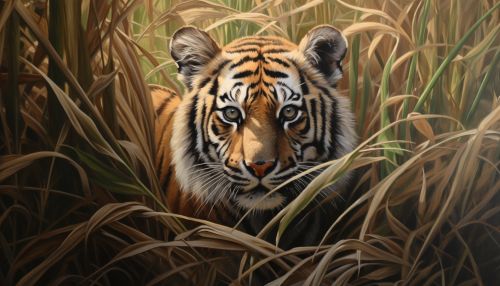Tiger
Taxonomy and Evolution
The Tiger (Panthera tigris) is a member of the Felidae family and the largest species among the cat family. Tigers are apex predators, primarily preying on ungulates such as deer and bovids. They are territorial and generally solitary but social animals, often requiring large contiguous areas of habitat that support their prey requirements. This, coupled with the fact that they are indigenous to some of the more densely populated places on Earth, has caused significant conflicts with humans.


Tigers are among the most recognizable and popular of the world's charismatic megafauna. They have featured prominently in ancient mythology and folklore and continue to be depicted in modern films and literature. Tigers appear on many flags, coats of arms, and as mascots for sporting teams. The tiger is the national animal of several Asian nations, including India.
Characteristics
Tigers are most recognizable for their pattern of dark vertical stripes on reddish-orange fur with a lighter underside. They have a muscular body with powerful forelimbs, a large head, and a tail that is about half the length of their body. Their skull is similar to a lion's skull, with the frontal region usually less depressed or flattened, and a slightly longer postorbital region. Furthermore, the tiger also has somewhat rounder features. The lion skull shows broader nasal openings. Due to the variation in skull sizes of the two species, the structure of the lower jaw is a reliable indicator for their identification.
Distribution and Habitat
Tigers are native to much of Asia, from some of the coldest regions to the steamy rainforests of the Indonesian Islands. They are found in a variety of habitats, including grasslands, savannas, and deciduous forests, as well as cold coniferous forests in the northern parts of their range such as Siberia. The tiger is a versatile predator, able to adapt to a variety of habitats. However, all tigers require dense vegetative cover, proximity to water, and an abundance of prey to survive.
Behavior and Lifestyle
Tigers are solitary predators, hunting primarily from dusk till dawn. They are not very successful in terms of catching their prey—only about one in every ten to twenty attempts is successful. Tigers are also excellent swimmers and often bathe in ponds, lakes, and rivers, thus keeping cool in the heat of the day.
Conservation
Tigers are currently listed as "Endangered" on the IUCN Red List of Threatened Species. The primary threats to tigers are habitat loss and poaching for their body parts, which are used in traditional Asian medicines. Tigers are also victims of human-wildlife conflict, particularly in areas where population growth and an increase in agriculture have led to shrinking tiger habitats.
